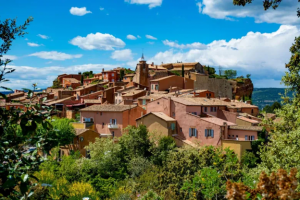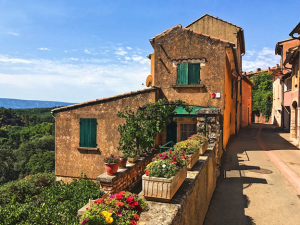Let’s say you’re on a wine tasting visit to the Southern Rhône. Everywhere you go, there seems to be a mountain hovering over you. One of them is Mont Ventoux, the Windy Mountain, and it is emblematic of the region. You might wonder, what’s on the other side of that mountain. The answer is that there are other wine producing areas, the Vaucluse and the Luberon. They make pleasant wines, not as well known as the ones from the Côtes du Rhône.
The voyage over the mountains is worthwhile in itself. For one thing, the panorama is breathtaking. Wherever you’re driving from, you will cross many beautiful little villages as you drive over Ol’ Windy. In many years, a stage of the Tour de France goes up the Mont Ventoux; they will return to the mountain this year. No matter how hot it is when you leave the valley floor, you’ll find it to be quite chilly at the top of Mont Ventoux. At the crest of the mountain there used to be a meteorological station; the building is still there even if it’s not used anymore.
 The village of Roussillon. Photo courtesy of Civitatis.
The village of Roussillon. Photo courtesy of Civitatis.
Once you get over the mountains, we recommend that you make your way to the village of Roussillon (pronounced roo-see-yon). Although they’re spelled the same way, this village has nothing to do with Languedoc-Roussillon further to the west. This quiet spot is ensconced in a Natural Regional Park, so that even if some tourists do find their way there, it is relatively unspoiled (or at least it was when we were last there).
 Along the walls of Roussillon. Photo courtesy of The Savvy Bostonian.
Along the walls of Roussillon. Photo courtesy of The Savvy Bostonian.
The town is built from stone quarried there in years past. The rocks are full of ochre, a red-orange clay that has long been used to make artists’ paint. Thousands of years ago, the prehistoric people living in what is now the south of France used it for body decoration and for coloring their famous cave art. In Roussillon, the ochre creates a village where all the buildings are red, yellow, orange or shades in between. French villages in general are charming; this one has charm pouring from every colored wall.
The best way to soak in all that charm is just to walk around. There are steep stone streets (but no cars) where you pass quaint homes. There’s an ancient Romanesque church, with “new” facades from the 17th century. There’s a market on Thursday mornings and there’s a town square in front of the Mairie (town hall) where you ought to stop for a coffee, a meal or a glass of wine
Most of all, you should walk the walls overlooking the old quarries. Roussillon sits atop a mass of red rock, and you can see it from the walkway. You can take a stroll on the Ochre Trail (sentier des ocres) and walk into the quarries. In particular, try to see Roussillon at the end of the day, when the color of the setting sun makes the walls of Roussillon and its surrounding seem to come ablaze. It’s an awesome sight that you’ll never forget.
If in your wine-tasting travels in the Southern Rhône you want to spend a little time in the perfect Provençal village, you’ll find it in Roussillon.